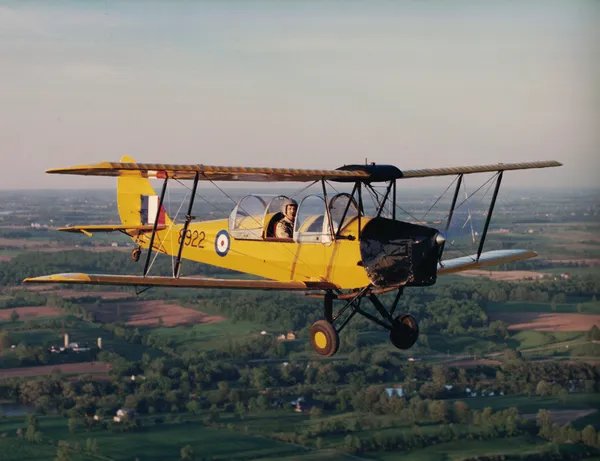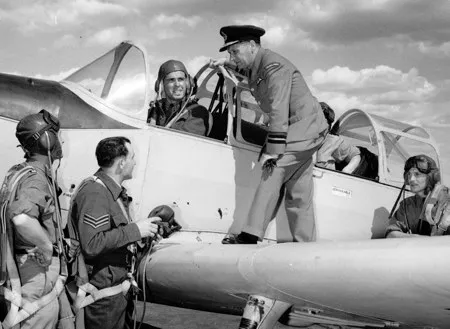Perera, Kingsley Wilfred Milroy
Killed in Flying Accident 1942-12-08


Birth Date: 1913-October-12
Born:
Son of John David and Mary Constance Perera, of Kandy, Ceylon.
Home:
Enlistment:
Enlistment Date: Unknown
Service
RAFVR
Unit
31 EFTS- Elementary Flying Training School (RAF)
Base
DeWinton, Alberta, Canada
Rank
Leading Aircraftman
Position
Leading Aircraftman
Service Numbers
1399700
First Burial
 Burnsland Cemetery, Calgary, Alberta, Canada
Burnsland Cemetery, Calgary, Alberta, Canada
This incident involved multiple aircraft:
- Moth, Tiger I Serial: 4200
- Moth, Tiger I Serial: 5826
All the above aircraft in the above list are referenced in this report.
de Havilland DH 82 Tiger Moth

The de Havilland DH.82 Tiger Moth is a 1930s British biplane designed by Geoffrey de Havilland and built by the de Havilland Aircraft Company. It was operated by the Royal Air Force (RAF) and many other operators as a primary trainer aircraft. In addition to the type's principal use for ab-initio training, the Second World War saw RAF Tiger Moths operating in other capacities, including maritime surveillance and defensive anti-invasion preparations; some aircraft were even outfitted to function as armed light bombers.
The Tiger Moth remained in service with the RAF until it was succeeded and replaced by the de Havilland Chipmunk during the early 1950s. Many of the military surplus aircraft subsequently entered into civil operation. Many nations have used the Tiger Moth in both military and civil applications, and it remains in widespread use as a recreational aircraft in several countries. It is still occasionally used as a primary training aircraft, particularly for those pilots wanting to gain experience before moving on to other tailwheel aircraft.
Overseas manufacturing of the type commenced in 1937, the first such overseas builder being de Havilland Canada at its facility in Downsview, Ontario. In addition to an initial batch of 25 Tiger Moths that were built for the Royal Canadian Air Force (RCAF), the Canadian firm began building fuselages which were exported to the UK for completion. Canadian-built Tiger Moths featured modifications to better suit the local climate, along with a reinforced tail wheel, hand-operated brakes (built by Bendix Corporation), shorter undercarriage radius rods and the legs of the main landing gear legs being raked forwards as a safeguard against tipping forwards during braking. In addition the cockpit had a large sliding canopy fitted along with exhaust-based heating; various alternative undercarriage arrangements were also offered. By the end of Canadian production, de Havilland Canada had manufactured a total of 1,548 of all versions.Wikipedia
 Wikipedia de Havilland Tiger Moth
Wikipedia de Havilland Tiger Moth
 YouTube de Havilland DH.82A Tiger Moth
YouTube de Havilland DH.82A Tiger Moth
31 EFTS (31 Elementary Flying Training School)
An Elementary Flying Training School (EFTS) gave a trainee 50 hours of basic flying instruction on a simple trainer like the De Havilland Tiger Moth, Fleet Finch, or Fairchild Cornell over 8 weeks.Elementary schools were operated by civilian flying clubs under contract to the RCAF and most of the instructors were civilians. For example, No. 12 EFTS Goderich was run by the Kitchener-Waterloo Flying Club and the County of Huron Flying Club.The next step for a pilot was the Service Flying Training School.

For More Information on RCAF Station DeWinton see here



 Bomber Command Museum of Canada
Bomber Command Museum of Canada
 Vintage Wings - Ghosts of Southern Alberta
Vintage Wings - Ghosts of Southern Alberta
No. 31 Elementary Flying Training School was formed on 18 June 1941 and was located at De Winton, Alberta. No. 31 EFTS was originally under the control of the RAF as part of the British Commonwealth Air Training Plan within No. 4 Training Command. The Toronto Flying Club also known as the Malton Flying Training School Limited, took over operations from the RAF on 13 July 1942. No. 31 EFTS was to have been disbanded on 25 August 1944 but under Organization Order No. 407, dated 13 July 1944, the date was amended to 25 September 1944.
Project 44 BCATPMoth, Tiger 4200
Moth, Tiger I 4200
With No. 31 Elementary Flying Training School at De Winton, Alberta. Crashed on 8 December 1942 at De Winton, killing Leading Aircraftman K.W.M. Perera. Strike off date also reported as 4 March 1943.1940-09-25 Taken on Strength 2019-08-20
1942-January-19 Accident: 15 Elementary Flying Training School Loc: Aerodrome Regina Names: Jackson | Macgregor
1942-December-08 Accident: 31 Elementary Flying Training School Loc: Gladys Ridge Names: Perera | White
1943-01-11 Struck off Strength 2019-08-20
Moth, Tiger 5826
Moth, Tiger I 5826
Delivered to No. 10 Repair Depot in Calgary. First used by No. 5 Elementary Flying Training School at High River, Alberta. Category C14 damage at High River aerodrome at 11:30 on 16 February 1942. Category B crash at High River at 15:15 on 17 April 1942. To M&C Aviation in Prince Albert, Saskatchewan for repairs, 23 April to 7 July 1942. Had 540:05 logged time when it arrived there. To storage with No. 4 Training Command when completed. Issued from storage on 12 September 1942, probably for use by No. 31 Elementary Flying Training School at De Winton, Alberta. Category A crash at De Winton on 8 December 1942. Leading Aircraftman A.H.W. White, RAFVR, killed.1941-10-07 Taken on Strength No. 4 Training Command 2019-08-20
1942-February-16 Accident: 5 Elementary Flying Training School Loc: Relief Aerodrome Names: Richmond | Striowski
1942-April-17 Accident: 5 Elementary Flying Training School Loc: NWest Of High River Names: Richmond | Sharpe
1942-December-08 Accident: 31 Elementary Flying Training School Loc: Gladys Ridge Names: Perera | White
1943-02-19 Struck off Strength Struck off, reduced to spares and produce at No. 10 Repair Depot 2019-08-20
 Commonwealth War Graves Commission
Commonwealth War Graves Commission www.findagrave.com
www.findagrave.com Library and Archives Canada Service Files (may not exist)
Library and Archives Canada Service Files (may not exist) Harold A Skaarup Web Page
Harold A Skaarup Web Page